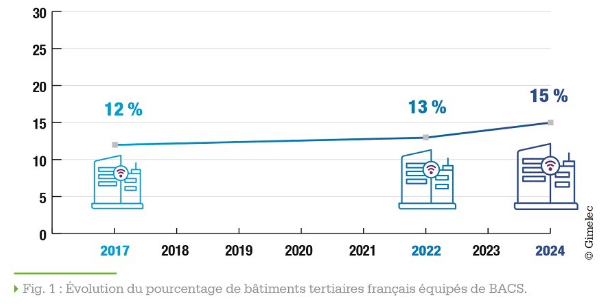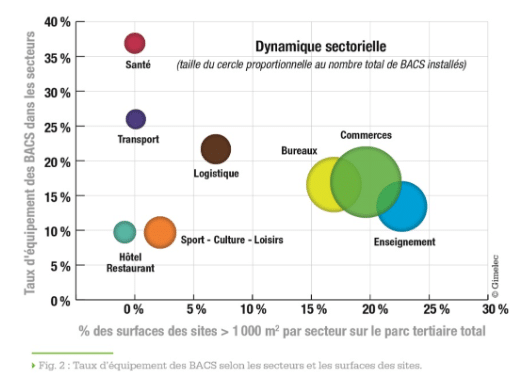BACS issues and compliance: an imperative necessity for tertiary buildings
The BACS Decree requires all tertiary buildings to install a technical building management system (BMS) to optimize energy consumption.
Eligibility of the BACS Decree
The BACS decree (Building Automation & Control Systems) was published in July 2020 and requires the installation of building automation and control systems GTB (Technical Building Management) for tertiary buildings. This decree aims to improve the energy performance of buildings by making it compulsory to install systems allowing the management, monitoring and optimization of energy consumption.
- The main obligations of the decree include:
- The installation of a BACS system for new buildings or during major renovations.
- The integration of devices allowing the automatic regulation of heating, ventilation, air conditioning (HVAC), and lighting.
The implementation of management systems to monitor energy consumption in real time, which facilitates the identification of areas for energy savings.
Application schedule
The timetable for application of the BACS Decree is as follows:
- Since April 8, 2024 for new buildings whose equipment has a cumulative nominal power greater than 70 kW.
- January 1, 2025 for existing buildings whose equipment has a cumulative nominal power greater than 290 kW.
- January 1, 2027 for existing buildings whose equipment has a cumulative nominal power greater than 70 kW.
Compliance still limited
According to the Department of Housing, Urban Planning and Landscapes at the Ministry of Energy Transition, 40% of the French tertiary sector is affected by the BACS Decree. Or 390 million m2*.
Despite these compliance requirements , only 15% of tertiary sites in France were equipped in 2024, representing 37% of tertiary surfaces, according to the electrical flexibility barometer published by RTE, Enedis and GIMELEC**.

Compliance that varies depending on the sector of activity. Thus 40% of health buildings such as hospitals are already equipped. Likewise, 25% of stations have already been put into working order:

This low coverage rate can be explained by several obstacles identified in the RTE and GIMELEC study:
The installation of BACS in multi-occupant buildings is often supervised by facility managers (FM) or subcontractors, which complicates coordination and increases costs.
In single-user sites, these systems are often managed by the occupant, requiring training for optimal operation.
The lack of availability of a simplified offer, adapted to small and medium-sized areas. For example, for areas up to 5000m2 a non-wired BMS makes it possible to respond to the BACS Decree while reducing costs by up to 45% compared to a traditional solution.
Growing needs for network flexibility: opportunities for BACS
Massive electrification of uses
From today, the energy transition towards a low-carbon economy requires changes in daily uses:
Electric heating method (e.g. heat pump) to replace much more carbon-intensive fossil fuels (oil and gas boiler)
Development of electric mobility to decarbonize transport, the highest emitting sector in France (30% of Greenhouse Gas emissions)
The boom in renewable energies (ENR)
The current energy context, characterized by a very strong integration of renewable energies, leads to increased variability on the electricity network depending on the intermittent production phases of this type of energy (solar or wind for example).
This variability in the supply of carbon-free electricity requires a capacity for increasing flexibility to ensure the balance of the network and optimize the consumption of kWh produced based on ENR.
Tertiary buildings, as charging points, play a key role in this energy transition by becoming clean energy hubs. They can integrate energy storage systems, thus contributing to optimized long-term energy management. The Electricity thus stored in an electric car battery can then be reinjected into the network later, at a time when the solar power plant will not produce enough to cover consumption at a given time. This concept, often called Vehicle-to-Grid (V2G), transforms electric vehicles (EVs) into active elements of the electricity grid, offering multiple benefits.
GTB key to making the electricity network more flexible
According to the RTE study on flexibility, BACS systems can offer a substantial contribution to network flexibility by synchronizing consumption with electricity production, particularly in buildings equipped with charging stations (IRVE) or other large loads (such as lighting and elevators).
However, concrete actions remain limited, partly due to a lack of financial incentives and sustainable operational initiatives:
Currently, certain operations such as EcoWatt, allowing voluntary reductions in consumption during periods of tension, are little mobilized for lack of lasting incentives. Furthermore, targeted interventions, such as load shedding policies, remain marginal and depend on one-off incentives. For site managers, these solutions are considered demanding in terms of skills and resources, and require technical capabilities that are not yet accessible to all sites, particularly smaller ones.
Finally, BACS have clear advantages for flexibility, but require better integration and demonstration of their capabilities for operators. Indeed, the interoperability of systems is seen as an essential criterion to guarantee sustainable investments. At the same time, the development of charging stations (IRVE) within sites represents a unique flexibility opportunity. Indeed, IRVEs constitute the most activatable consumption item and are already integrated into power regulation approaches, thus allowing sites to actively contribute to network balancing.
